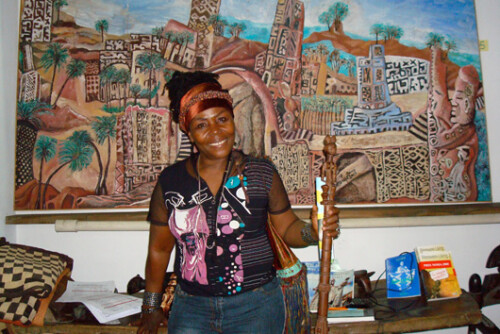Choreographic Signatures and “Bodily Intelligence”
However much Baker responds to and draws inspiration from the community, what perhaps stands out most about her performance in this film excerpt is that it is full of her signature moves: the shimmy; the classic Charleston “monkey knees,” in which her hands crisscross her splaying knees; the standing struts, in which she bends one knee at a time and swings her arms in opposition; and the crow or chicken pose, in which she freezes in a turned-in plié with her elbows bent and her hands pointed out. Baker did not invent these moves, but the frequent use of the term “signature” to describe them—in addition to others, like her eye-crossing, fingertip flexing, and placement of her finger on the crown of her head—establishes an affiliation between her and them that approximates an assertion of authorship.1 In other words, by mastering certain dance steps and gestures, performing them in a distinctive style, and enacting them repeatedly in a variety of venues, Baker implicitly claimed them as her own. Given the debt her dancing owed to black vernacular traditions, Baker’s success in developing what we might think of as corporeal autographs—a sort of bodily writing of her name in and through performance—arguably amounted to another kind “wresting of the composing voice,” this time away from the largely uncredited community of dancers who influenced her.
To be sure, while Baker’s repertoire was based on African-American vernacular idioms and her style was rooted in an Africanist aesthetic tradition, it was the idiosyncrasy of her dancing that set her apart. Commentators, struggling for the right words to characterize her physicality, pointed frequently to the energy, eccentricity, and humor of her moving body. As one London critic wrote, “any inch of her body, an elbow-tip, or a shoulder-blade, is more sentient and expressive than most people’s countenances.”2 Even in the flattened medium of film, Baker’s kinetic articulateness and fluidity are unmistakable. One minute she is kicking her legs, swinging her arms, swaying her hips, tilting her head, smiling, and rolling her eyes all at once, and the next she abruptly switches directions, drops into a deep lunge, and bounds across the floor. These “high-affect juxtapositions”3 and dynamic facial expressions contributed to the comedic tenor of her dancing—what the French critic André Rouverge described as “the genius to let the body make fun of itself.”4 Whosever moves she was performing, Baker stamped her dancing with an exuberance and zaniness that became her personal calling cards and enabled her to reap some of the chief rewards of authorship: recognition and financial remuneration.
Well aware of the conditions of her success, Baker once told an interviewer, “It is the intelligence of my body that I have exploited, and that is what has turned me into an international star.”5 This remark speaks volumes about the contingencies and consequences of choreographic authorship for Baker. From a position of relative powerlessness, Baker managed to mine the one form of capital she possessed in abundance—what she terms her bodily intelligence. The phrase encapsulates two things simultaneously: Baker’s refusal of the raced and gendered hierarchies prescribed for her, and her embrace of a different model of artistic authority. First, by ascribing an intelligence to her body, Baker confounds mind/body divisions that were supposed to relegate her to the position of the docile/primitivist body reflexively executing moves preordained by agentive/rational choreographers. And second, she shifts the locus of agency to her own thinking body; it was, she suggests, her corporeal aptitude for mimicry, improvisation, humor, and stylistic individuality—and her ability to judge when to deploy each of these skills—that authored her rise from uncredited chorus girl to global celebrity.
Finally, then, the question of who should be considered the choreographer of the dancing Baker performed can have no single or definitive answer. In arguing for an understanding of Baker’s dancing as an act of creative artistry that allowed her to usurp a good portion of the author function, I am not proposing that she should be considered a genius choreographer who deserves sole credit for fashioning the movement performances that made her famous. My purpose is not to dismiss the craft and invention of those who directed, produced, designed for, and helped shape her dancing. Rather, my point is that the nature of her dancing forces us to contemplate questions of dance authorship; it is the fact that she elicits the question “whose choreography?” in the first place that is significant. If Baker’s improvisatory resistance, development of signature moves, and bodily intelligence disrupt the primacy of the (historically white and typically male) choreographer, they also encourage us to approach authorship as a site where contests for power are waged both discursively and corporeally.
- Peggy Kamuf defines a “signature piece” as “a device repeatedly associated with a subject” (3). [↩]
- Hubert Griffith, “Josephine Baker at Home,” London Observer Oct. 8, 1933, Harvard Theater Collection. [↩]
- Brenda Dixon Gottschild identifies “high-affect juxtaposition”—the “mood, attitude, or movement breaks” that contrast the smooth transitions of European aesthetic codes—as one of the core principles of an Africanist aesthetic (14-15). [↩]
- Quoted in O’Connor and Hammond, 42. [↩]
- Quoted in O’Connor and Hammond, 90. [↩]




